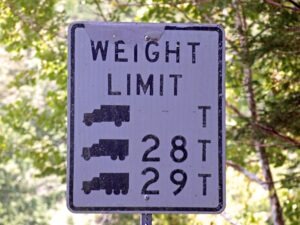
Commercial trucks must comply with several different types of weight limits. In a one-sentence answer: The different commercial truck weight limits are gross vehicle weight limits, axle weight limits, and bridge formula weights. Each serves a different safety purpose.
Showing violations of the weight limits without proper permits can help accident victims seek compensation. An Indianapolis truck accident lawyer can use evidence of violations to show the trucker was negligent in an accident.
What Is Gross Vehicle Weight Rating (GVWR)?
Gross Vehicle Weight Rating represents the maximum weight a truck can safely carry, including the vehicle itself, cargo, fuel, and occupants. Federal law sets the standard GVWR limit at 80,000 pounds for interstate commercial vehicles without special permits. This total weight limit helps prevent dangerous operating conditions that could lead to accidents.
GVWR varies by truck class, with Class 8 trucks having the highest ratings of 33,001 pounds or more. Lower classes have progressively smaller weight ratings, affecting the types of cargo they can legally transport.
This commercial truck weight limit becomes crucial in accident cases where cargo weight may have contributed to the crash. Violations of gross vehicle weight ratings can show negligent loading practices or attempts to maximize profits at the expense of safety.
Your Case Will Get
The Attention It Deserves

What Are Axle Weight Limits?
Axle weight limits specify the maximum weight each axle configuration can safely support. On interstate highways, single axles are limited to 20,000 pounds, while tandem axles can carry up to 34,000 pounds. These limits prevent excessive road damage and maintain vehicle stability during operation.
Different axle configurations also help with vehicle weight distribution. Tridem axles, consisting of three consecutive axles, typically allow higher total weights when properly spaced. This is why large vehicles may have several wheels next to each other to support the load.
Proper weight distribution across axles helps prevent tire blowouts, brake failures, and other mechanical issues. Exceeding axle weight limits can lead to dangerous handling characteristics. Overloaded axles may cause steering problems, reduced braking efficiency, and increased stopping distances.
How Does the Bridge Formula Weight System Work?
The bridge formula determines the maximum allowable weight based on axle number and spacing. By limiting weight concentration over short distances, this formula prevents excessive stress on bridge structures.
Bridge formula violations often occur when truckers or loading crews fail to consider axle spacing. These miscalculations can result in dangerous weight concentrations that exceed bridge structural limits. Even when the total weight remains under GVWR, improper distribution can damage the bridge.
These regulations exist specifically to prevent catastrophic bridge failures and maintain infrastructure safety. Understanding bridge formula weights helps establish liability in accidents involving structural failures or loss of control on a bridge.


What Are Trailer Weight Ratings?
Trailer weight ratings differ from overall truck GVWR and require separate compliance monitoring. Each trailer has its own Gross Trailer Weight Rating (GTWR), which indicates the maximum weight it can safely carry, including the weight of the trailer itself. These ratings affect the total vehicle weight calculations and safe loading practices.
Multiple trailer combinations, such as doubles or triples, require careful attention to weight distribution. Each connection point between trailers has specific weight limits that affect stability and control. Exceeding these connection point ratings increases the risk of trailer separation or loss of control, even if the total weight remains under GVWR.
Load placement within trailers affects both weight ratings and vehicle handling. Proper weight distribution between the front and rear of trailers helps maintain appropriate tongue weight and prevents dangerous sway conditions. Improperly distributed loads can cause handling problems even when within overall weight limits.

Indiana-Specific Weight Limits
Indiana enforces additional weight restrictions beyond federal requirements on state and local roads. These limits may vary by route, season, and vehicle type, particularly for agricultural transportation. Special routing requirements apply to overweight vehicles operating with permits.
Local bridge and road restrictions often impose lower limits than state or federal standards. These restrictions reflect the specific construction and condition of local infrastructure. Counties and municipalities may post their own weight limits based on engineering assessments.
State weight enforcement focuses on protecting infrastructure while maintaining commercial efficiency. Regular weigh station inspections and mobile enforcement units monitor compliance with these limits.
What Are the Methods of Commercial Truck Weight Limit Enforcement?
Fixed weigh stations serve as primary enforcement points along major highways. These facilities use certified scales to verify compliance with all weight restrictions and maintain detailed records of each weighing. Modern weigh stations often incorporate automated systems that can check credentials and weight without requiring all trucks to stop.
Mobile enforcement units allow officers to conduct weight checks anywhere in the state. These units use portable scales to verify compliance on secondary roads and alternate routes where some trucks may try to avoid fixed weigh stations. Mobile enforcement helps prevent carriers from mapping routes to deliberately avoid weight verification points.
Weigh-in-motion (WIM) systems embedded in roadways continuously monitor truck weights at highway speeds. These systems help identify potential violators for further inspection while allowing compliant vehicles to maintain their schedule. WIM data also helps authorities track patterns of violations and adjust enforcement strategies accordingly.
Hurt by a Commercial Truck? Contact a Truck Accident Lawyer
The weight a semi can haul safely depends on the commercial truck’s weight limits. When carriers violate commercial truck weight limits–whether GVWR, axle weights, or bridge formula calculations–they put everyone at risk. Knowing when the weight limits are broken can help establish liability in truck accident cases.
At Vaughan & Vaughan, we have spent decades investigating weight-related violations and their role in serious accidents. Our thorough approach to gathering evidence about weight limit violations has helped us secure substantial settlements. Contact us today to discuss how truck weight violations may have contributed to your accident.




